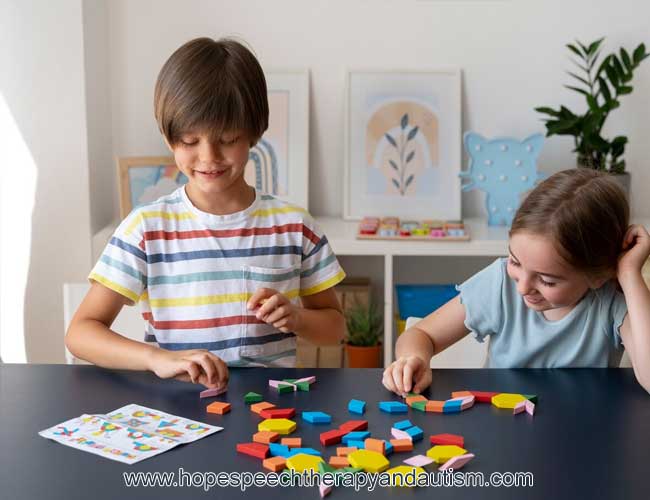Occupational / Sensory Integration Therapy in Kolkata
Kolkata's Best Occupational Threapy / Sensory Integration Therapy Treatment Services
Hope Centre for Occupational / Sensory Integration Therapy Treatment in Kolkata
Occupational Therapy (OT) and Sensory Integration Therapy are therapeutic approaches designed to support individuals in developing or improving the skills needed for daily life activities. These therapies are often employed to address challenges related to sensory processing, motor coordination, and overall functional independence. Let's explore each concept separately:
Occupational Therapy (OT)
Occupational Therapy is a healthcare profession focused on promoting health and well-being through meaningful and purposeful activities. Occupational therapists work with individuals of all ages to address physical, cognitive, and emotional challenges that may impact their ability to engage in daily activities, also known as "occupations." Hope Centre for Speech Therapy Treatment Center is the best Occupational Therapy Centre in Kolkata with Sensory Integration Therapy for Children.
Key Components
Assessment and Evaluation
Occupational therapists conduct comprehensive assessments to understand an individual's strengths, challenges, and goals. These assessments may cover various areas, including motor skills, self-care abilities, cognitive function, and sensory processing.
Goal Setting
Based on the assessment, occupational therapists collaborate with individuals to set personalized goals. These goals often center around improving independence in activities of daily living (ADLs), such as dressing, eating, grooming, and school or work-related tasks.
Fine Motor Skills
OT addresses fine motor skills, which involve the coordination and control of small muscles, particularly in the hands and fingers. Activities may include writing, buttoning clothing, and using utensils.
Gross Motor Skills
OT also targets gross motor skills, focusing on larger muscle groups responsible for activities like walking, running, jumping, and maintaining balance.
Sensory Integration
Occupational therapists may use sensory integration techniques to help individuals process and respond appropriately to sensory input. This is particularly relevant for individuals with sensory processing disorders or challenges.
Adaptive Equipment
Occupational therapists may recommend and train individuals to use adaptive equipment or assistive devices that enhance independence in daily activities. This can include modified utensils, dressing aids, or wheelchair adaptations.
Cognitive Rehabilitation
For individuals with cognitive challenges, OT includes cognitive rehabilitation to improve memory, attention, problem-solving, and executive functioning skills.
Workplace or School Modifications
OT may involve recommending modifications to the physical environment to make it more accessible and conducive to an individual's needs. This can include adjustments in lighting, seating, or workspace organization.
Pediatric OT
In pediatric occupational therapy, therapists work with children to develop essential skills for school readiness, social interaction, and participation in age-appropriate activities.
Mental Health Support
OT plays a role in mental health by addressing the impact of mental health conditions on daily functioning. Therapists may use therapeutic activities to promote emotional well-being.
Sensory Integration Therapy
Sensory Integration Therapy is a specific type of occupational therapy that focuses on helping individuals process and respond to sensory information from their environment more effectively. It is commonly used for individuals with sensory processing disorders, autism spectrum disorders, and other conditions affecting sensory integration.
Key Components
Sensory Processing Assessment
Sensory Integration Therapy begins with a thorough assessment of an individual's sensory processing abilities. This assessment helps identify specific sensory challenges and preferences.
Sensory Activities
Therapists use a variety of sensory activities to provide controlled exposure to different sensory stimuli. These activities aim to improve the brain's ability to process and integrate sensory information accurately.
Proprioceptive and Vestibular Input
Sensory integration often involves activities that target proprioceptive (body awareness) and vestibular (balance and spatial orientation) input. This can include activities like swinging, jumping, or heavy work tasks.
Desensitization and Modulation
For individuals who are hypersensitive or hyposensitive to certain sensory stimuli, therapists use techniques to desensitize or modulate these responses. This helps individuals achieve an optimal level of arousal and responsiveness.
Coordination and Motor Planning
Sensory Integration Therapy emphasizes activities that enhance coordination and motor planning. This can include tasks that require precise movements and sequencing of actions.
Individualized Programs
Sensory Integration Therapy is highly individualized, with therapists tailoring activities to address specific sensory challenges identified during the assessment process.
Parent and Caregiver Involvement
In many cases, parents and caregivers are involved in sensory integration therapy. Therapists provide guidance on incorporating sensory activities into the individual's daily routine at home.
Environmental Adaptations
Therapists may suggest modifications to the individual's environment to support sensory integration. This could involve creating sensory-friendly spaces or using sensory tools like fidget items.
Collaboration with Other Therapies
Sensory Integration Therapy often works in conjunction with other therapeutic interventions, such as speech therapy, occupational therapy, and physical therapy, to provide comprehensive support.
Progress Monitoring
Therapists continuously monitor the individual's progress and adjust the sensory activities based on their changing needs and responses.
In summary, Occupational Therapy encompasses a broad range of interventions to enhance overall daily functioning, while Sensory Integration Therapy specifically targets challenges related to sensory processing. Both therapies aim to improve an individual's quality of life by promoting independence, enhancing motor skills, and addressing sensory difficulties.
Are you looking for Occupational / Sensory Integration Therapy Treatment Centre in Kolkata?
Your search may ends here and you are at right place, Hope Centre for Autism Treatment in Kolkata City in West Bengal, can help you. Our experienced, professional, Speech & Autism Therapists have been changing lives by helping your children / kid communicate & behave better with their families, teachers & the society.
So, Don't Wait!! Contact Us Now.
Kolkata Address:
Hope Centre for Autism Treatment
81, Sarthak Apartment, Rajdanga Main Rd, near Acropolis Mall, Nabapally, Bosepukur Purbapara, Rajdanga, Kasba, Kolkata, West Bengal 700107
Location Map:
https://maps.app.goo.gl/Fffg6k8r88sQc3nP9




